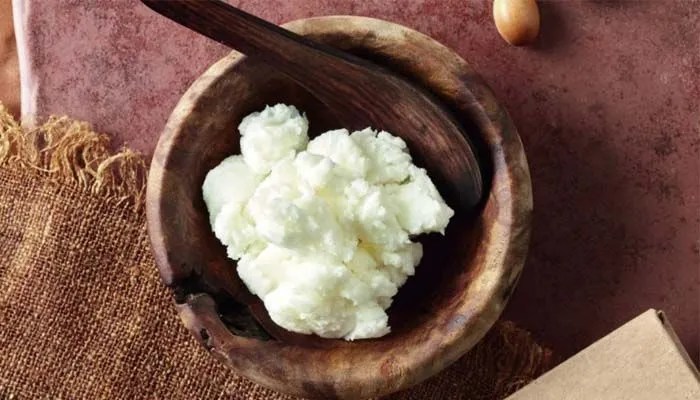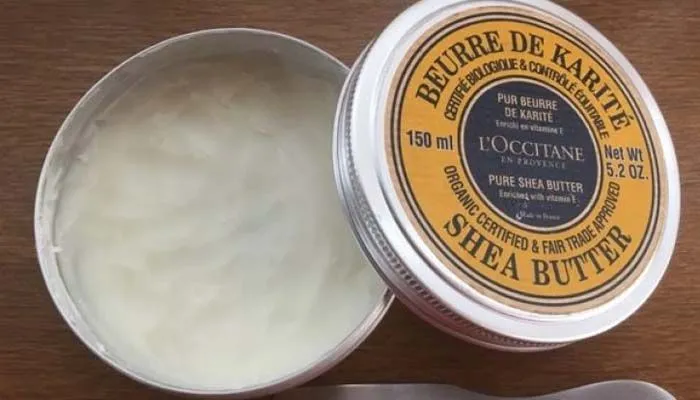The plant world provides us with various sources of unsaturated fats considered, in proportionate amounts, as healthy. One of them is shea mateca, extracted from the shea tree and used as the main ingredient for various cosmetic products.
In this article we want to show you the importance of this compound of natural origin and the multiple benefits it has for our health.
Table of Contents
Where does shea butter come from?
Shea butter is a source of natural fat extracted from the fruits of the shea tree (Vitellaria paradoxa). These fruits, nutty in appearance, have a beneficial unsaturated fat, solid appearance and whitish color. The shea tree is native to West Africa, and virtually all of the world’s shea production comes from this area.
Although today it is common to find it in a great diversity of modern cosmetic products, shea butter has been used by humans for hundreds of years, where all its properties focused on moisturizing the skin or accelerating wound healing were already known.
These properties are due to its high concentration in various vitamins, as well as several groups of interesting fatty acids for skin hydration. Being a fat, it has many facilities to be incorporated into the skin or hair, and is very useful to moisturize, soften and improve the resistance of the epidermis.
However, it doesn’t all end here. We propose more than 20 reasons to incorporate this vegetable butter into your day to day as a personal hygiene product.
Active components
The chemical composition of shea oil is unique, due to the presence in different concentrations of the following elements:
- Fatty acids: linoleic, palmitic, stearic and oleic. Moisturizing effect on the skin
- Vitamins A, E and F: antioxidant activity.
- Triglycerides: restores the properties of the skin and provides a moisturizing effect.
- Esters: the waxy appearance that favors moisture retention.

Main benefits of shea butter
It is a product of natural origin
This butter is extracted naturally from the shea tree. The largest source of fatty acids is obtained, as usual in the plant world, from fruits, with a nutty appearance. Its protein content is low, so it concentrates a large amount of unsaturated and healthy vegetable fats. Today, there is little evidence of possible allergic reactions, and if there are, they are mild in nature and resolve quickly.
Another interesting advantage of shea fat applied to the skin is that it works for all skin types, especially dry and easily irritable ones.
It has a great hydration capacity
One of the main uses of shea butter is its moisturizing potential. In fact, it is incorporated into a large number of cosmetic products whose purpose is to improve the texture of the skin, moisturize and protect it from possible irritations. In addition, due to its waxy properties, it prevents the loss of water through the pores of the epidermis.
It contains essential and unsaturated fatty acids, such as palmitic acid, oleic acid, linoleic and stearic acid, among others. Applied to the skin, these oils have easy absorption and act as a moisturizing agent, restoring the lipid layer of our epidermis and quickly recovering lost moisture. Therefore, shea butter acts as a natural protective layer.
Its use is highly recommended for dry, scaly skin and for the relief of itching related to dryness.
Does not accumulate excessively on the skin
For skin hydration, there are several types of fat. Those related to vegetables, such as oleic and linoleic acid, are related to each other and have a high absorption capacity in the skin, so it is not excessively greasy and the hand is impregnated and sticky. Applied to the skin and rubbing it well all over the surface, in a few seconds it is absorbed in its entirety.
Possesses anti-inflammatory capacity
Research related to the properties of shea butter has found chemical groups related to vegetable origne esters very interesting for their anti-inf properties.lamatory.
Therefore, when we apply this lotion on the skin, it delays the processes related to inflammation through the production of cytokines. This is interesting when we suffer from epidermal disorders such as dry skin due to dry weather, eczema or mild inflammation.
Possesses antioxidant activity
The advantages of using shea over other compounds common in moisturizers is based on its high concentration of vitamins A and E. Both compounds have an important anti-inflammatory activity easily absorbed by the skin.
Both vitamins are scientifically related to the delay of premature aging of the skin, since they have complexing activity on free radicals that cause premature cellular oxidation.

It is considered an antibacterial and antifungal agent
A 2012 study using the bark of Vitellaria paradoxa showed considerable reduced antimicrobial activity in the animals subjected to the test.
Rigorous studies in humans have not yet been established, so although the scientific evidence is limited, it presages a pharmaceutical interest in the use of this fat of vegetable origin.
Increases natural collagen production
The triterpenes are natural compounds present in some vegetables that are formed by long chains of up to 30 carbons. This element is active in shea cream, so when we apply it on the skin, it has the ability to reduce the destruction of collagen fiber. Therefore, it keeps the skin smooth, better hydrated and prevents the appearance of wrinkles.
Shea butter activates cell regeneration
Every day there is the replacement of thousands of dead cells by new ones, renewing the physiological process in all organs. The properties of shea butter benefit cell rejuvenation by providing a balance of surface moisture and eliminating the layer of dead cells, to favor the activity of renewed ones.
Reduces the formation of stretch marks and improves healing
Several investigations are studying the role of shea butter in reducing scar tissue formation (keloid fibroblasts). In this way, the formation of thick layers of skin that cause stretch marks and bad scarring is reduced.
Can act as sunscreen
Vegetable fatty acids such as linoeic acid and oleic acid keep the skin perfectly hydrated and reduce the harmful effect of the sun’s rays. Although not very high, a shea-based cream application on the skin offers 3-4 point SPF protection. Therefore, it should not replace but complement the current sunscreens, which many of them incorporate this vegetable fat as an additive.
In turn, it is also interesting to apply it when we have suffered some type of mild sunburn. It keeps the skin hydrated and its vitamins A and E reduce the presence of oxidative free radicals. The anti-inflammatory substances present can reduce redness and swelling, plus the presence of fatty acids can soothe the skin and help retain moisture during the healing process.
Improves hair elasticity and reduces dandruff
One of the biggest hair problems is the breakage of weak hair andspero. Although there are currently many personal hygiene products that strengthen hair, shea butter is one of them.
By also restoring capillary moisture levels, it reduces the formation of dandruff, which are basically dead skin cells typical of an irritated and moisture-free scalp.
However, more needs to be studied how this substance actually works and whether it is better alone or mixed with other ingredients commonly used for the treatment of dandruff.
Reduces the sensation of itching typical of dermatitis and psoriasis
An interesting use of shea vegetable fat is the reduction of the itching sensation caused by irritated skin when we suffer from dermatitis. The anti-inflammatory properties favor the relief of itching and the restoration of optimal moisture to the skin.
The latest research argues that this substance works just as well as other creams commonly used for the treatment of eczema.
Reduces pain caused by arthritis
Other studies have found positive evidence in protecting stiff and inflamed muscles, helping to repair tissue.
How to use shea butter

Applied to the skin
Shea cream or oil is applied directly to the skin, just like any other usual cream. It is easy to spread due to its fat content and is quickly absorbable thanks to linoleic and oleic acid.
Applied to hair
There are several products that contain this ingredient among its components. If not, you can also directly apply the shea cream on the hair, spreading it evenly over it. It absorbs quickly and restores the properties of the hair.
Recommended articles on the skin
Source of information
- Antibacterial activity and subchronic toxicity studies of Vitellaria paradoxa stem bark extract. Journal of Pharmacology and Toxicology.
- Patient acceptability, efficacy and skin biophysiology of a cream and cleanser containing lipid complex with shea butter extract versus a ceramide product for eczema. Hon KL 1 , Tsang YC 1 , Pong NH 1 , Lee VW 2 , Luk NM 3 , Chow CM 1 , Leung TF 1.
-
Comparison of oil-based ointment versus standard practice for the treatment of moderate burns in Greece: a trial-based cost-effectiveness assessment. Vilelmine J Carayanni , 1 Evangelia G Tsati , 2 Georgia CH Spyropoulou , 3 Fotini N Antonopoulou , 4 and John D Ioannovich.
-
Shea nut oil triterpene concentrate attenuates the development of knee osteoarthritis in rats: evidence of knee joint histology. Jen-Hsin Kao , 1, 9 Sheng-Hsiung Lin , 2 Chun-Fu Lai , 3, 4 Yu-Chieh Lin , 5, 6 Zwe-Ling Kong , 7 and Chih-Shung Wong
